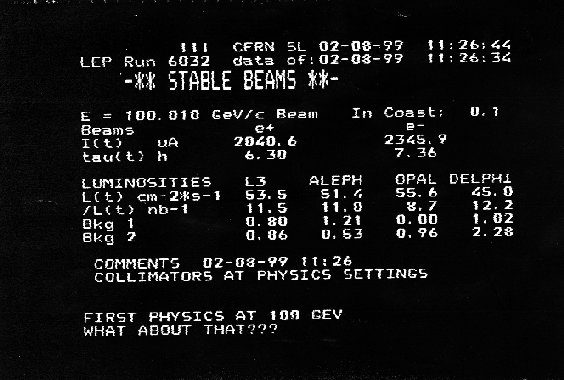Geneva, 4 Augist 1999. At CERN1 on 2 August 1999 at 11h15, beams of electrons and positrons were accelerated in the Large Electron Positron Collider (LEP) to 100 GeV and brought into collision for the first time at this energy. There were two reasons for the backslapping, cheering and popping of corks that followed in the LEP control room. First, the setting of a new energy record for an electron-positron accelerator, represents a tremendous technical achievement by CERN accelerator specialists. Second, the collision energy of 200 GeV opens up exciting new discovery potential for the LEP experiments.
Almost exactly 10 years ago, 13 August 1989, the first collisions took place in experiments on CERN's 27km accelerator. Since then, LEP has seen a progressive rise in the energy of its particle beams (see Box), producing a wealth of high precision physics results. After 6 years of research on the Z0 particle at the collision energy of 91 GeV, LEP produced its first pairs of W particles in 1996 at 161 GeV. The accelerator was again boosted in 1997 and 1998 and was operated at 184 GeV and 189 GeV respectively. Reacting to the permanent pressure for higher energy and more luminosity from experimenters, a major upgrade was proposed for operating LEP "flat-out" during its last years of service before the laboratory concentrates on the construction and installation of the Large Hadron Collider (LHC), CERN's future accelerator. Nearly all the major systems, including radio frequency installations, the cryogenics and the vacuum equipment, were upgraded and some were pushed far beyond their original design specification. The LEP team's success in squeezing the maximum performance from the installations to reach 100 GeV per beam, demonstrates accelerator physics at its best.
This progressive increase in LEP's energy has been driven by the search for the Higgs boson. Particle physicists are as yet unable to explain the masses of fundamental particles. Is there some underlying reason why quarks and leptons have their particular masses? Why are these masses distributed over such a large range (the top quark is 3.5 million times more massive than the electron), and why do some particles have mass while others are apparently massless?
The present 'answer' to these questions is provided by the subtle 'Higgs' mechanism. For the last ten years LEP, with increasing energy and a higher integrated luminosity, has been closing in on the Higgs.
Precision measurements performed at LEP have recently predicted a mass of around 109 GeV for the standard model Higgs boson. This means that to produce the Higgs in association with a Z boson -- the dominant production process at LEP2 -- a collision energy of at least 200 GeV is required. The accelerator can now produce these conditions and physicists in each of the four LEP experiments, ALEPH, DELPHI, L3 and OPAL are now eagerly analysing data in the search for new physics.
Energy Increases at LEP
1989
Acceleration was performed using the room temperature copper radio-frequency system which consisted of 128 five cell cavities with a potential voltage of 400MV. In parallel with the successful operation on the Z0 peak until 1995, research and development was being carried out to provide the technology and production techniques for high gradient superconducting cavities.
1995
A few test modules of superconducting cavities were installed which allowed the energy to be raised to 70 GeV/beam.
1996
The beam energy reached the W-pair production energy for the first time and physics data was taken at beam energies between 80.5 and 86 Gev.
1996-1997
During the winter shutdown a further complement of superconducting cavities was installed, raising the total complement to 192 cavities.
1997
The beam energies were at 91-92 GeV, well above the W-pair threshold.
1998
LEP operated at 94.5 GeV with 272 superconducting cavities. Record integrated luminosity of 200 pb-1
1999
Subsequent increases in beam energy from 96 GeV in May, to 98 GeV in July, culminating with 100 GeV in August.
August 1999
LEP operating at 100 GeV per beam, i.e. a collision energy of 200 GeV. At this energy LEP operates at the limit on many fronts; in particular the radio-frequency system which, optimistically designed for gradients of 6MV/m, must operate all 288 cavities at an average gradient of 7MV/m. The total RF voltage per turn needed is 3400MV, and the synchrotron radiation beam power at this energy is a staggering 18MW, testing the vacuum components to the limit and requiring careful control of the experiments' background. Nevertheless the first physics run at 200 GeV collision energy was very successful, resulting in more than 320 nb-1 in each of the four detectors.
1. CERN, the European Laboratory for Particle Physics, has its headquarters in Geneva. At present, its Member States are Austria, Belgium, Bulgaria, the Czech Republic, Denmark, Finland, France, Germany, Greece, Hungary, Italy, Netherlands, Norway, Poland, Portugal, Slovakia, Spain, Sweden, Switzerland and the United Kingdom. Israel, Japan, the Russian Federation, the United States of America, Turkey, the European Commission and Unesco have observer status.

